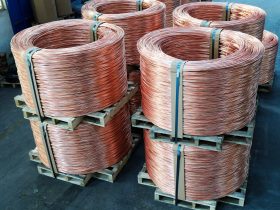Gilead Sciences, Inc. (NASDAQ:GILD) Jefferies 2024 Global Healthcare Conference June 5, 2024 11:00 AM ET
Company Participants
Merdad Parsey – Chief Medical Officer
Conference Call Participants
Michael Yee – Jefferies
Michael Yee
I am very happy to have up here with us Chief Medical Officer of Gilead, Merdad Parsey. It’s great to have you with us fresh off of four or five days of ASCO. So lots to talk about.
Question-and-Answer Session
Q – Michael Yee
Maybe just opening up for Gilead, I’d love to just have your view of the world about where Gilead sort of R&D pipeline is today, because I would say to be fair and I’m — not only my reports, but others, there’s been a lot of commentary around the development on oncology and some of the other acquisitions oncology or not. And so people are wondering whether Gilead is on the right track on the R&D pipeline. Maybe just describe maybe the two or three key points that you see about it to be excited that maybe the Street has not seen and to address some of that sort of criticism. Thanks.
Merdad Parsey
Thanks. Thanks for having me. Great question. Thanks for opening that way, because I think that is very helpful. I do think that there’s been a lot a lot of chatter. And I think from our perspective, people are kind of missing, I think the broader story, right? And for me and the way I think about it and the way I would encourage others to think about it, we are building a company, right? We’re building a company and we’re — the core of our business remains our HIV business, has been and will continue to be for the foreseeable future. And I think our HIV pipeline, our current assets in our pipeline are best in the industry, and I think we’re hitting on all cylinders there and I’m very, very excited about that.
Michael Yee
Definitely no criticism in HIV, yes.
Merdad Parsey
Yes. And I think people — that’s to me, I think a huge part of the bigger-picture. And then what I would add is then in oncology, we’re growing. We’re building. We’re growing, cell therapy aside, I think we’re building a portfolio and as you — when you do so, you have some wins and losses. But overall, I think we’re — I’m very happy with the direction we’re headed and we can talk about that more in a second.
And then in inflammation, we just added Seladelpar and I think that’s another addition to our portfolio. Our goal has been to diversify, right, to be HIV plus. And by adding inflammation assets, adding oncology, it’s a very challenging and difficult thing to do. Many have tried and it’s a difficult thing. We’re about 3.5 years into our oncology journey. We’re very young oncology company with what I would describe as a very early pipeline, but I’m really proud of how much we’ve diversified and where our agents are.
I think if you look across our oncology pipeline, I think with Trodelvy, look, we had a hazard ratio of 0.51 in triple-negative. That’s meaningful, and I think that’s been really impactful. We are adding to the story for Trodelvy. Story is not over. We have a lot of data that we’re generating and coming up and so I think that’s really great and we have a number of things in the pipeline behind that.
So I’m really happy with where we are and where we’re headed.
Michael Yee
Let’s kind of break down some of those oncology areas since we did come away from ASCO. So just, first, obviously, the most important, I’d say, a driver outside of cell therapy is Trodelvy. And so Trodelvy is growing, obviously, and it’s approved indications as well ramping in HR-positive breast cancer. But there were two slip-ups. One was in lung cancer, which we’ll talk briefly about and then in bladder cancer, I don’t want to spend too much time on that. But also in breast cancer, you have some data coming, but there’s also competition.
So talk about how you see Trodelvy growing over the next five years because Wall Street sees either that lung cancer was a slip-up, so that was came down. I think there’s a write down on that. And then in breast cancer, there are competitors coming, Daiichi, Astra, et-cetera, et-cetera. So how do you grow over the next few years and that because people see competition?
Merdad Parsey
Yes. Thanks. Yes, so I’d start by saying we are still the only two ADC that’s approved. And people — fortunately competition is always good and are going to drive us, but I’m really glad.
Michael Yee
It’s actually twist, that it’s not 100% that Daiichi will be approved later this year.
Merdad Parsey
No comment. Yes, sir. So I think that’s key. Yeah, look, and I think what I would say has been consistent across Trodelvy is that in every study we’ve done, there’s activity. We’ve seen good activity. Second line lung is a really difficult space. You look at our data, a hazard ratio of 0.83. It’s — while it didn’t hit what we were hoping to hit, there’s a clear benefit in a lot of patients and the tolerability profile there looks — look down the AE tables and we have fewer AEs on the Trodelvy arm than in docetaxel. We — and if I look at the aggregate data for lung and where we’re headed for lung, the frontline study, which is our EVOKE-03 study, I think we feel a lot of — when behind ourselves in some ways because the EVOKE-01 data…
Michael Yee
Yes.
Merdad Parsey
Clear activity. EVOKE-02 data, which we showed — last year when we showed the ORR data at World Lung, the caution we gave is you combine chemo with pembro, you’re going to get high ORRs. We’re excited about them, but we need to see it translate into PFS and OS. And with the caveat that it’s a small dataset, the PFS data we showed at ASCO Monday really give us a lot of optimism in that we showed a PFS of over 13 months.
Michael Yee
And what would you expect for PD-1 alone or chemo combo?
Merdad Parsey
Yes. And that’s a great question. I think the PD-1 alone in this area and PD-1 with chemo combo, the PFSs are in the eight, nine months.
Michael Yee
Okay. What number, you are at?
Merdad Parsey
And we’re 13 plus, right? We’re a bit over 13 months. And I think this issue about chemo combos in frontline lung is an interesting one in that. It is part of the practice pattern to use either pembro monotherapy or pembro plus chemo. Appropriately I think a lot of folks use that. And what you see is when you add chemo to pembro in the frontline, you do get better response rates early, but you don’t seem to get much of a PFS or OS dependent.
Michael Yee
That’s fair. So number one is, you believe that the opportunity for Trodelvy in lung cancer is greater than expected because you will work on Trodelvy plus PD-1 and you should beat PD-1 alone in the EVOKE-03 study?
Merdad Parsey
I’m not sure greater than expected, because I know what your expectations are.
Michael Yee
The expectation on Wall Street are really modest.
Merdad Parsey
We think we’re on the right track, right, is what…
Michael Yee
Based on the EVOKE-02 data at ASCO.
Merdad Parsey
That’s right.
Michael Yee
Showed 60 something percent response rate. Higher than chemo combo.
Merdad Parsey
Exactly.
Michael Yee
PFS 13 months, higher than chemo combo.
Merdad Parsey
Exactly.
Michael Yee
And actually your point was that the response rates are higher than chemo combo already, but their response rates are higher than monotherapy, but that did not lead to a PFS benefits despite the fact that doctors insist on using chemo combo, which is my view, I know you guys sort of say no people do use monotherapy?
Merdad Parsey
It’s a mix.
Michael Yee
Your point is you think you’re better than chemo combo anyway.
Merdad Parsey
I think if we can show, what I hope we can show is an improvement in PFS and OS, that’s the bar. I think that has a lot of potential for us in the long run.
Michael Yee
Okay. And when would that data EVOKE-03 first line lung cancer readout?
Merdad Parsey
Yes, the study is enrolling really well. We’ve pointed to 2025 plus for that. It will probably be a little bit later than ’25, but it all depends on enrollment. It’s going very well.
Michael Yee
It’s PFS endpoint.
Merdad Parsey
OS endpoint.
Michael Yee
OS standpoint.
Merdad Parsey
And that is a study we’re doing together with Merck in combination with Pembro. They’re actually running the study. And so — and they’re doing an amazing job executing.
Michael Yee
I’m going to ask a tough — the only wildcard there then is that what I would see is that PFS and OS in lung cancer don’t always perfectly translate from ORR, certainly in breast cancer as well. We know that. And so despite the fact that you have higher ORR and you just pointed to me that chemo combo did not show higher PFS and OS than just monotherapy. So the same thing would apply to you unless there’s some magic science is there?
Merdad Parsey
I don’t believe in magic science. That’s faith-based science.
Michael Yee
Does Trodelvy will add a PFS benefit.
Merdad Parsey
Yes, we’re — so I think let me tease that apart a little bit. I think you’re absolutely right in breast cancer that PFS ends up being the endpoint precisely because it’s difficult to translate into OS because in breast cancer, the survival times tend to be longer and there’s a lot more crossover post-study.
Michael Yee
Many different drugs.
Merdad Parsey
In many — so what you see in general in late — in early line breast cancers in particular is a focus on PFS is an endpoint. And PFS does not always predict OS usually because there’s more noise in the OS signal. By contrast in lung cancer, the PFS does predict the OS better. And so there is a bit of a dichotomy there in terms of those.
Michael Yee
Okay. And so we will lean on a better durability of the response, higher responses, better durability and the PFS data you have shown and we’ll continue to follow.
Merdad Parsey
We think all those things support our Phase-3 trial.
Michael Yee
And to be clear for those because it’s the same debate with TIGIT that the magnitude of the result will also be better cross-trial comparison than chemo [Indiscernible], because everyone just says everybody uses chemo combo. So even though you’re saying you’re beating PD-1 and chemo combo is not the control arm, you’re going to be better than that cross-trial.
Merdad Parsey
We recognize that we need to demonstrate a better PFS and a better…
Michael Yee
Commercial uptake in those of things.
Merdad Parsey
No, for patients, right? I think we need to make sure we’re…
Michael Yee
Okay.
Merdad Parsey
We’re bringing something.
Michael Yee
So that’s one is lung cancer. Other competitors are going there too, but you’re running that study and that’s up. What about in breast cancer? One of the things that has come up is that in HR-positive breast cancer, you see Trodelvy growing, but Daiichi says, hey, we have ultra-low HER2 now coming out of ASCO this weekend and that I saw their slide expanding more across all. They wanted the discussers like why do we need to test for HER2, just using everybody. I would be interested in your response there because that would be impinging on your market.
And then two is that Daiichi Astra are also running a TROP2 first-line triple-negative. Your results coming, we actually got a lot of questions from clients this week about when that data is coming because they’re also reported. So HR positive where they’re coming in on ultra-low and also triple-negative?
Merdad Parsey
So let’s separate the two. So for HR-positive, look, I think in HER2 is a great drug. It’s bringing tremendous value to women — men and women with breast cancer and it’s showing up something great. And I think it’s important to recognize that we’re different targets, right? We’re going after TROP2. They’re going after HER2. And while there is overlap between those populations, there are also places where there is no overlap. And I think in triple-negative in particular, where we talked about, I think those patients are going to benefit from Trodelvy and that’s where we believe we’re bringing a huge amount of benefit. And in HR-positive, it’s difficult to suggest that patients wouldn’t be better served by getting Trodelvy in — when their HR — when their HER2…
Michael Yee
Zero.
Merdad Parsey
It’s zero.
Michael Yee
Certainly zero.
Merdad Parsey
It certainly seems that that’s the case. And I think it’s challenging for us to know how to translate the ultra-low into practice today. I think you heard that from the discussion as well. And so, look, at the end of the day, these both are going to bring benefit to patients. And I think in the HR low population, I certainly have more confidence that Trodelvy will bring that back.
Michael Yee
I would say that and certainly again reflective of what there’s already represented in the stock and the valuation that in HER2, we will be a commonly used drug in that setting. Yes, it may or may not be used in front of Trodelvy, but it’s a different target. It’s not the same target. So go ahead and use in HER2. Trodelvy could be your next option anyways.
One of the questions come up is whether there is going to be and I’m sure someone is looking at this, evidence to look at whether there is impact on TROP2 use and efficacy, both not only with yours, but also with Daiichi and I can’t remember if the mechanism is that same, but people have talked about cross-resistance off of in HER2. So because of the chemo that’s on or the toxin off of in HER2, just following that then with TROP2, because of the toxin have some overlap in terms of the mechanism as it relates to the rate cycle? You’ve heard about this?
Merdad Parsey
Yes. It’s a — yes, it’s hypothetical. I think it’s difficult to know. I don’t think there are any data, clinical data, and certainly, we’ve seen that with because SN38 is a different payload than what either Daiichi brings or in either case, I think we feel comfortable and we’re seeing a lot of sequential use and we’re studying. So I think it’s — right now, I’m not sure there is a — it’s something to think about, but I don’t think there’s any data to worry about that. Should we…
Michael Yee
To talk about — I want to talk about triple-negative. Triple negative Phase 3 first-line data coming possibly later this year.
Merdad Parsey
That’s right.
Michael Yee
Apparently in the recent last earnings call, you said you could file it or whatever, but talk about when first line triple-negative data is coming and do you expect to be better or how do I compare and contrast that because AstraZeneca will also have Phase 3 data, same setting?
Merdad Parsey
Yes. So look, I think, yes, to your point, ASCENT-03 is our frontline. We have two frontline studies going on. One is in the PD-L1 low population and the other — that’s and ASCENT-03. ASCENT-04 is in the PD-L1 high population. ASCENT-03 will be done, we think late this year, maybe early next year or late this year, early next year again in August.
Michael Yee
It’s in combo with PD1 high?
Merdad Parsey
Yes. So this is the PD-L1 low population is ASCENT-03. And then ASCENT-04 our PD-L1 high population that will be coming later, that’s going to take a little bit longer. Partly because remember we were just talking that PFS is longer, so it will take longer for the PD-L1 study to read out.
Michael Yee
But in ASCENT-03…
Merdad Parsey
And in ASCENT-03, PD-L1 high. So as we’ve said that we expect late this year, maybe into next year, but we think this year. And then it’s hard to predict head-to-head what — I can’t predict. What I can do is say based on what we’ve seen so far, I like that our tolerability profile in breast cancer has been strong. We see diarrhea and neutropenia. Those are well-managed. We do not see Grade 3 stomatitis. We do not see ILD at that extent — at the extent that others have seen. So we think that — if we can bring something that brings the efficacy that we’re anticipating and is…
Michael Yee
A better tolerability…
Merdad Parsey
And it’s tolerated well.
Michael Yee
Don’t really have stomatitis, right?
Merdad Parsey
We do not see the extent, neither the severity nor the frequency. So I think those are — again, we’ll have to let the data read out. And once we both have data, we can do more of a compare and contrast. But we like our chances there.
Michael Yee
Should I pivot anywhere else on Trodelvy or should I move to a different program? Those are the two big ones I think.
Merdad Parsey
Yes. I think…
Michael Yee
EVOKE-03 lung cancer next year, if that’s positive, that would move you into a first-line setting. You said later in ’25.
Merdad Parsey
’25 plus.
Michael Yee
’25 plus, okay. ’25 plus.
Merdad Parsey
We need to fully enroll.
Michael Yee
And then first-line triple-negative end of this year or early, And you could file on that data?
Merdad Parsey
We believe so.
Michael Yee
Okay.
Merdad Parsey
It’s a Phase 3.
Michael Yee
Okay.
Merdad Parsey
Registrational trial.
Michael Yee
Okay. And then secondarily, maybe what would you point me to, I’d pivot to TIGIT, but then I think it’s like the same thing and people say, well…
Merdad Parsey
In oncology…
Michael Yee
Because this is supposed to be your most important growth driver. So TIGIT was one of those…
Merdad Parsey
Yes, so in oncology — so just to move then to TIGIT, that is the next, I would say, most mature program we have coming through in Phase 3 for both lung and — as we showed our EDGE-Gastric data at ASCO, where we are encouraged by the data that we’re seeing there in combination in gastric CA and that’s also in Phase 3. That study is enrolling incredibly well. And so we think that study will be — the potential for that one if it reads out the way we hope it will. we will be ahead of the competition in terms of being able to file. So we should be first in-class if gastric works out.
Michael Yee
Okay.
Merdad Parsey
The other thing I’d say about TIGIT is what we’re seeing EVOLVE is part of our hypothesis for why we took an FC null molecule into the clinic was that we believed we would get better tolerability. And I think as you see the data come out, we are really happy with what the tolerability profile looks to be with TIGIT. Our hypothesis has always been that — excuse me, that in order to get TIGIT approved, not only do you need the efficacy, you need the tolerability, and the tolerability critically for us within for combinations within the portfolio is really critical. If you have a drug that’s well-tolerated when added to a PD-1, it gives you flexibility to think…
Michael Yee
Is there a TIGIT Trodelvy?
Merdad Parsey
We are — there are some early studies that we’re doing to look at that combination and see if there is a — if we can get even better activity.
Michael Yee
Okay. One last question, if I may because it was reminded to me that on your Trodelvy lung cancer study, just one last question on Trodelvy that obviously you presented the data and you highlighted this big subgroup of prior non-responders of PD-1, which is two-thirds of the study. Most people don’t get a great response from PD-1 and that you kind of leave it open that you’re discussing with FDA. Is that like a legitimate we would like to try and file that or what?
Merdad Parsey
We would definitely like to try to file that. I think it’s — as I think it’s true for all of us when you take a study where the primary endpoint wasn’t met, it raises the bar and it’s — while this was a predefined subgroup because of the primary endpoint, it makes it more challenging and is the patient population with a huge unmet need, they don’t really have great options. We’re showing, in particular in that subset evidence of efficacy and good tolerability. So we think it’s worthy of having a discussion to see if we can do something for patients.
Michael Yee
When could we hear an update on whether that’s yes or no?
Merdad Parsey
I think it will be sometime this year.
Michael Yee
Sometime this year. Okay. All right. Let me pivot to two other things. One is, I would like to talk about HIV because there are two important drivers. One is the fact that you have Phase 3 PrEP data coming. And the other is the fact that I believe that if you could tell Wall Street, you did have a long-acting regimen for the treatment of HIV like once every six months, I think everybody would agree that that would be a very great option for people and that would extend your HIV business further. People believe you can do this because you guys crush it in HIV.
Merdad Parsey
We believe we can as well.
Michael Yee
Okay.
Merdad Parsey
So and…
Michael Yee
So tell me when a six-month type data, where are you at six-month injections?
Merdad Parsey
Yes. So I’ll remind that we will have Phase 2 data for every six-month lenacapavir plus bNAb…
Michael Yee
Lenacapavir plus bNAb?
Merdad Parsey
Which is an every six month regimen that will be this year. So it will be — it’s early. I want to always caution it’s really Phase 2 data, but I think that will be very directionally important for us. So that’s our — I think that’s a starting point.
Michael Yee
For the treatment of HIV.
Merdad Parsey
For the treatment of HIV.
Michael Yee
Now just to remind everybody in the treatment of HIV would just bNAbs, it was basically positive?
Merdad Parsey
Yes, we had the — it was lenacapavir plus bNAb.
Michael Yee
Oh, there’s lenacapavir plus bNAb. Okay, yes.
Merdad Parsey
Lenacapavir plus bNAbs in the treatment study and we saw 18 to 20 patients who did…
Michael Yee
And that was like a monthly?
Merdad Parsey
No, every six months.
Michael Yee
That was every six months.
Merdad Parsey
Yes.
Michael Yee
Okay.
Merdad Parsey
So because the bNAbs are there for six months, right? And the Lenacapavir we already know is going to be there for six months. So we’re very encouraged by that. We need to build more data. I think there’s a lot more work to be done. So I want to make sure we’re…
Michael Yee
So what would we learn in this data coming up?
Merdad Parsey
Well, I think this would be sort of broadening and — the number of patients in the trial, getting us more confidence. That was 20 patients. This will be a larger sample size.
Michael Yee
Okay.
Merdad Parsey
So getting us confidence and then helping define patient populations that we would go into potentially for registrational trials. If we go that path and I just want to there’s a big if there. So we would be…
Michael Yee
What would be the if? The only caveat for Wall Street is that it’s basically for half the population who have that antigen…
Merdad Parsey
To which has bNAb…
Michael Yee
To which bNAb bond, so 50% of the market is nice.
Merdad Parsey
Yes.
Michael Yee
So why would you not go forward?
Merdad Parsey
I want to see the data first.
Michael Yee
Okay.
Merdad Parsey
So once we see the data, we’ll make that decision. So…
Michael Yee
That you — so that’s one.
Merdad Parsey
Yes, so that’s one.
Michael Yee
What others.
Merdad Parsey
So I think — just I want to make sure I answered that six-month question directly. And to your point, I think very importantly, the lenacapavir every six-month PrEP studies, PURPOSE-1 and PURPOSE-2 will be reading out. PURPOSE-1 later this year and PURPOSE-1 potentially this year, maybe early next year. Those are the two studies we need for registration for PrEP. They’re both very large studies, just under 6,000 and just under 4,000 people in those two trials. And we’re very encouraged by those data. And I think we believe it will be a real sea change for PrEP, right? These are — every six-month injections would be a far cry from daily pills.
Michael Yee
What percent of people do you think currently on DESCOVY would swap to this? And what percent of people do you think out of 100 people would start this because they don’t want to take daily pills?
Merdad Parsey
I think that’s the exact right question, Mike.
Michael Yee
I haven’t done that certainly yet.
Merdad Parsey
Yes. I think we believe that the availability of an every six-month injection not only allows those who would rather not take one every day or are non-compliant with taking one every day to go. But we also believe that it will expand the lens for people who — remember, again, it’s healthy people, right? These are people without an infection.
There’ll be a lot more people willing to take PrEP if they know that they’re going to be protected for six months and come in, get an injection six months — and are covered for six months. So we do think there’s both the transition of some people…
Michael Yee
And also growing the market.
Merdad Parsey
And then growing the market. And I think that potential for the market growth given what the recommendations are from even the CDC for PrEP in people who have two sexual partners or more, those sorts of things. It’s…
Michael Yee
Even 10% of the market, one out of 10 of people who are not technically at risk. I think is material, but we need to do some more survey work and I was hoping you’d maybe share your survey work.
Merdad Parsey
We’re — we think it’s going to make an impact and we’re really looking forward to that. So I think that’s — when you think about underappreciated, I think that may be one area.
Michael Yee
How about this? Can PrEP ever be reimbursed and a monetizable revenue situation outside the United States?
Merdad Parsey
Well, I would definitely say that we believe there’s a possibility that will happen and we believe the reason for that is we will be able to — part of what we’re aiming to show is that the ability to cover someone for six months to have compliance guaranteed for six months will lead to better outcomes for people, right, and that should be something that is — brings more value to healthcare systems.
Michael Yee
Someone who is taking pills and may not be on it, so they could get infected and therefore the value is not proportional.
Merdad Parsey
So we think there is — I mean, we believe that for public health, I mean that — the ability to really prevent infections in a much more impactful way.
Michael Yee
So once we get the data, again, this is a longer-term thing, but you would like to love that because I understand GSK does have approval.
Merdad Parsey
Yes.
Michael Yee
For their PrEP long-acting monthly.
Merdad Parsey
Monthly, yes.
Michael Yee
And yet they’ve told us it’s struggle for them.
Merdad Parsey
It is challenging I mean, I think that there’s no argument that in Europe, this is a more challenging.
Michael Yee
Thank you very much. We’ve run out of time. So we can talk for — I know, I know. We knew…
Merdad Parsey
There’s more to talk about.
Michael Yee
But thank you very much, Merdad. We’ll be in touch with you. And thank you for your time today.
Merdad Parsey
My pleasure. Thanks, Michael. Thanks for having me. Appreciate it.
Read the full article here









Leave a Reply